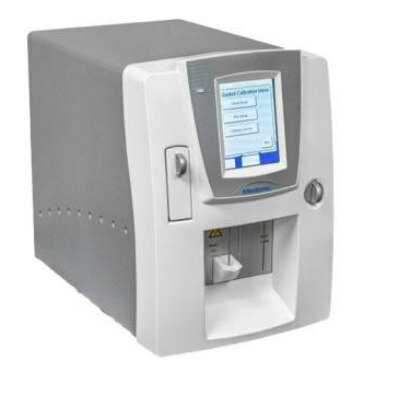Novel Nanosensing Technologies Developed for Exosome Detection and Profiling
|
By LabMedica International staff writers Posted on 20 Nov 2019 |

Image: The nano-plasmonic exosome (nPLEX) sensor (Photo courtesy of Massachusetts General Hospital).
Exosomes are extracellular vesicles (EVs) that are produced in the endosomal compartment of most eukaryotic cells. Liquid biopsy technologies have been developed to do high-throughput exosome protein profiling and point-of-care (POC) exosome analysis.
The aim is to develop multiplexed assay systems to streamline the analysis of exosomes and evaluate their clinical utility for cancer management, both as diagnostic tools and to predict disease recurrence. Nanoplasmonic sensors are fabricated to accommodate at most one exosome and individually imaged in real time, enabling the label-free recording of digital responses in a highly multiplexed geometry.
Scientists at the Massachusetts General Hospital (MGH, Boston, MA, USA) and their colleagues developed the nano-plasmonic exosome (nPLEX) sensor, in routine use at MGH, which detects exosome protein levels based on “spectral shifts” (intensity changes) of light through thousands of optimally spaced 200-nanometer (nm) holes. Antibodies against cancer biomarkers get immobilized on the nanopores for capture.
Nanoholes on the sensor are gold and exosomes are labeled by gold nanoparticles for signal amplification. Gold has proven to have the best chemical stability for this type of assay. The device is being manufactured on a glass-based substrate, as silicon wafers proved to be too fragile. The iMEX (integrated magnetic-electrochemical exosome) device, meanwhile, integrates vesicle isolation and detection in a single platform. Target-specific exosomes first get enriched through immunomagnetic selection, for high detection sensitivity. The sensors can be miniaturized and expanded for parallel measurements.
The nPLEX has demonstrated good accuracy and 100 times greater sensitivity than the commonly used enzyme-linked immunosorbent assay (ELISA) and able to detect as few as 3,000 exosomes. The team has also come up with a protein signature for pancreatic ductal adenocarcinoma (PDAC) that is powerful enough for diagnostic purposes, a combination of EGFR (epidermal growth factor receptor), EpCAM, MUC1, GPC1 and WNT2. As demonstrated in a prospective study involving more than 100 patients and age-matched controls, as the tumors shrink the biomarker combination gets lower and lower.
The scientists have also used nPLEX technology to show how exosome protein expression of cancer cells changes with drug treatment. Discovery of these unique, drug-dependent protein signatures suggests the exosome screening assay will be a potentially powerful molecular screening tool. Hyungsoon Im, PhD, an assistant professor of radiology and a senior author of the study, said, “The screening assay could be incorporated into point–of–care (POC) instruments for more rigorous testing of different drugs in different settings. The study was presented at the 2019 Next Generation Dx Summit held August 20-22, 2019 in Washington, DC, USA.
Related Links:
Massachusetts General Hospital
The aim is to develop multiplexed assay systems to streamline the analysis of exosomes and evaluate their clinical utility for cancer management, both as diagnostic tools and to predict disease recurrence. Nanoplasmonic sensors are fabricated to accommodate at most one exosome and individually imaged in real time, enabling the label-free recording of digital responses in a highly multiplexed geometry.
Scientists at the Massachusetts General Hospital (MGH, Boston, MA, USA) and their colleagues developed the nano-plasmonic exosome (nPLEX) sensor, in routine use at MGH, which detects exosome protein levels based on “spectral shifts” (intensity changes) of light through thousands of optimally spaced 200-nanometer (nm) holes. Antibodies against cancer biomarkers get immobilized on the nanopores for capture.
Nanoholes on the sensor are gold and exosomes are labeled by gold nanoparticles for signal amplification. Gold has proven to have the best chemical stability for this type of assay. The device is being manufactured on a glass-based substrate, as silicon wafers proved to be too fragile. The iMEX (integrated magnetic-electrochemical exosome) device, meanwhile, integrates vesicle isolation and detection in a single platform. Target-specific exosomes first get enriched through immunomagnetic selection, for high detection sensitivity. The sensors can be miniaturized and expanded for parallel measurements.
The nPLEX has demonstrated good accuracy and 100 times greater sensitivity than the commonly used enzyme-linked immunosorbent assay (ELISA) and able to detect as few as 3,000 exosomes. The team has also come up with a protein signature for pancreatic ductal adenocarcinoma (PDAC) that is powerful enough for diagnostic purposes, a combination of EGFR (epidermal growth factor receptor), EpCAM, MUC1, GPC1 and WNT2. As demonstrated in a prospective study involving more than 100 patients and age-matched controls, as the tumors shrink the biomarker combination gets lower and lower.
The scientists have also used nPLEX technology to show how exosome protein expression of cancer cells changes with drug treatment. Discovery of these unique, drug-dependent protein signatures suggests the exosome screening assay will be a potentially powerful molecular screening tool. Hyungsoon Im, PhD, an assistant professor of radiology and a senior author of the study, said, “The screening assay could be incorporated into point–of–care (POC) instruments for more rigorous testing of different drugs in different settings. The study was presented at the 2019 Next Generation Dx Summit held August 20-22, 2019 in Washington, DC, USA.
Related Links:
Massachusetts General Hospital
Latest Molecular Diagnostics News
- New Genetic Test Enables Faster Diagnosis of Rare Diseases
- Urine Test Detects Inherited Neuropathy Missed by Genetic Screening
- Genomic Test Predicts Risk of SCC Metastasis
- Microfluidic Device Predicts Pancreatic Cancer Recurrence After Surgery
- New Molecular Test Simultaneously Detects Three Major Fungal Infections
- Blood Test Guides More Effective Ovarian Cancer Treatment
- Liquid Biopsy Test to Enable Earlier Diagnosis of Numerous Cancer Types
- Blood Protein Profile Indicates Early-Onset Coronary Heart Disease
- New DNA Test Tracks Spread of Parasitic Disease from Single Sample
- Hidden Blood Biomarkers to Revolutionize Diagnosis of Diabetic Kidney Disease
- Genetic Testing Trifecta Predicts Risk of Sudden Cardiac Death and Arrhythmia
- Maternal Blood Test Detects Pre-Eclampsia Risk Before Symptoms Develop
- Blood Test Could Assess Concussion Severity in Teenagers with TBI
- Simultaneous Analysis of Three Biomarker Tests Detects Elevated Heart Disease Risk Earlier
- New Biomarker Panel to Improve Heart Failure Diagnosis in Women
- Dual Blood Biomarkers Improve ALS Diagnostic Accuracy
Channels
Clinical Chemistry
view channel
Chemical Imaging Probe Could Track and Treat Prostate Cancer
Prostate cancer remains a leading cause of illness and death among men, with many patients eventually developing resistance to standard hormone-blocking therapies. These drugs often lose effectiveness... Read more
Mismatch Between Two Common Kidney Function Tests Indicates Serious Health Problems
Creatinine has long been the standard for measuring kidney filtration, while cystatin C — a protein produced by all human cells — has been recommended as a complementary marker because it is influenced... Read moreMolecular Diagnostics
view channel
New Genetic Test Enables Faster Diagnosis of Rare Diseases
Rare disease diagnosis often involves a long and uncertain search for the underlying genetic cause. Traditional testing requires multiple separate analyses, although many patients remain without answers.... Read more
Urine Test Detects Inherited Neuropathy Missed by Genetic Screening
Sorbitol dehydrogenase (SORD)-related neuropathy is one of the most common inherited nerve disorders, yet diagnosis often lags because current genetic screens frequently miss the causal gene.... Read moreHematology
view channel
Platelet Activity Blood Test in Middle Age Could Identify Early Alzheimer’s Risk
Early detection of Alzheimer’s disease remains one of the biggest unmet needs in neurology, particularly because the biological changes underlying the disorder begin decades before memory symptoms appear.... Read more
Microvesicles Measurement Could Detect Vascular Injury in Sickle Cell Disease Patients
Assessing disease severity in sickle cell disease (SCD) remains challenging, especially when trying to predict hemolysis, vascular injury, and risk of complications such as vaso-occlusive crises.... Read more
ADLM’s New Coagulation Testing Guidance to Improve Care for Patients on Blood Thinners
Direct oral anticoagulants (DOACs) are one of the most common types of blood thinners. Patients take them to prevent a host of complications that could arise from blood clotting, including stroke, deep... Read moreImmunology
view channel
Chip Captures Cancer Cells from Blood to Help Select Right Breast Cancer Treatment
Ductal carcinoma in situ (DCIS) accounts for about a quarter of all breast cancer cases and generally carries a good prognosis. This non-invasive form of the disease may or may not become life-threatening.... Read more
Blood-Based Liquid Biopsy Model Analyzes Immunotherapy Effectiveness
Immunotherapy has revolutionized cancer care by harnessing the immune system to fight tumors, yet predicting who will benefit remains a major challenge. Many patients undergo costly and taxing treatment... Read moreMicrobiology
view channel
Rapid Assay Identifies Bloodstream Infection Pathogens Directly from Patient Samples
Bloodstream infections in sepsis progress quickly and demand rapid, precise diagnosis. Current blood-culture methods often take one to five days to identify the pathogen, leaving clinicians to treat blindly... Read more
Blood-Based Molecular Signatures to Enable Rapid EPTB Diagnosis
Extrapulmonary tuberculosis (EPTB) remains difficult to diagnose and treat because it spreads beyond the lungs and lacks easily accessible biomarkers. Despite TB infecting 10 million people yearly, the... Read more
15-Minute Blood Test Diagnoses Life-Threatening Infections in Children
Distinguishing minor childhood illnesses from potentially life-threatening infections such as sepsis or meningitis remains a major challenge in emergency care. Traditional tests can take hours, leaving... Read more
High-Throughput Enteric Panels Detect Multiple GI Bacterial Infections from Single Stool Swab Sample
Gastrointestinal (GI) infections are among the most common causes of illness worldwide, leading to over 1.7 million deaths annually and placing a heavy burden on healthcare systems. Conventional diagnostic... Read morePathology
view channel
Blood Test and Sputum Analysis Predict Acute COPD Exacerbation
Chronic obstructive pulmonary disease (COPD) remains a major contributor to global illness, largely driven by cigarette smoking and marked by irreversible lung damage. Acute exacerbations can accelerate... Read more
AI Tool to Transform Skin Cancer Detection with Near-Perfect Accuracy
Melanoma continues to be one of the most difficult skin cancers to diagnose because it often resembles harmless moles or benign lesions. Traditional AI tools depend heavily on dermoscopic images alone,... Read more
Unique Immune Signatures Distinguish Rare Autoimmune Condition from Multiple Sclerosis
Myelin oligodendrocyte glycoprotein antibody–associated disease (MOGAD) is a rare autoimmune disorder in which the immune system attacks the myelin sheath in the central nervous system. Although symptoms... Read moreIndustry
view channel
Abbott Acquires Cancer-Screening Company Exact Sciences
Abbott (Abbott Park, IL, USA) has entered into a definitive agreement to acquire Exact Sciences (Madison, WI, USA), enabling it to enter and lead in fast-growing cancer diagnostics segments.... Read more





















